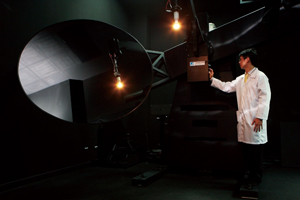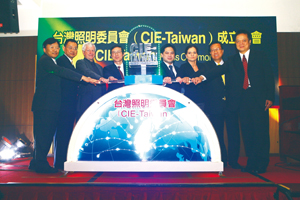Focus on Standards is Paying Dividends for Taiwan's LED Industry
Certification partnerships save sector time and money
2012/05/23 | By Ken LiuTaiwan's LED lighting industry has moved one step closer to reaching the goal of having all of its products worldwide receive one-stop certification, after the Center for Measurement Standards (CMS), part of the governmental Industrial Technology Research Institute (ITRI), unveiled a certification laboratory together with Underwriters Laboratories Inc. (UL) at its headquarters on March 2 in Hsinchu in northern Taiwan.

Although by volume Taiwan is recognized as the world's No. 1 LED supplier, due to varying industry standards from country to country, the island's LED manufacturers have had to test their products at different labs, making verification a time and money-consuming task.
"The root of the problem is that we are not an IEC (International Electrotechnical Commission) member," said T.C. Wu, director of CMS's Energy and Environment Metrology Division. "This makes it impossible for IEC, an UN-governed organization, to authorize a laboratory in Taiwan to conduct product examinations based on its standards. Should we have an IEC-approved laboratory here, our manufacturers could save a lot of time and money on verification."
UL: Key to World Markets
Familiar with the cooperation deal with UL, Wu said that the laboratory would provide Taiwan's LED lighting manufacturers with prompt access to world markets. "UL is a world-leading test laboratory that has opened an IEC CBTL (Certification Body Test Laboratory) in Denmark," he said. "This means that an approval received at the ITRI-UL laboratory will naturally be converted into European versions through UL IEC CBTL."
This laboratory will be Taiwan's first that conforms to LED lighting industry standards. With its own laboratory in Taiwan, UL has helped several local laboratories become CBTLs according to the International Electrotechnical Commission for Electrical Equipment's (IECEE's) CB Scheme. The UL laboratory only provides safety tests on electrical appliances, including lights, while the certified CBTLs provide tests on non-lighting appliances.
"Safety standards address factors that may threaten people's lives, such as electric shock and burning heat," Wu said. "Industry standards measure performance and reliability, such as lifespan and function quality. These standards might not be the same as mandatory tests, but they determine whether or not you're qualified to bid for government contracts."
The group of UL companies includes 1,158 in the United States and 306 in Canada, with 95 laboratory, testing and certification facilities worldwide as well as 160 satellite and inspection centers (there are 97 UL inspection centers and 63 UL-STR satellite locations). In total, the UL group of companies has published 1,464 safety standards and has certified 6,461 product items under the Energy Star program backed by the U.S. government. Globally, its marks appear on 22.4 billion products produced by 67,798 manufacturers, and its safety messages reach 3.1 billion consumers. "Around 20 or even 30 years ago, UL was tantamount to the global standard," Wu said.
According to Wu, ITRI signed the cooperation deal around two years ago, and the organization's several strong points convinced UL to team up with it. "ITRI is capable of doing not only safety tests but also industry standard tests on LED lighting products, and it has been selected by the government to draw up standards for the island's LED supply chains," he said. So far the Institute has completed LED industry standards for device, module and finished product sectors for the Taiwanese government's Chinese National Standards (CNS) system, which will soon include at least 50 more industry standards.
Although CMS is one of many ITRI organizations that have taken part in the government's LED standard projects, it is the only ITRI subdivision qualified for conducting product certification. "Unlike other organizations within ITRI capable of examining LEDs, we do not have R&D capabilities, which would have conflicted with the manufacturers' interests," Wu said.
CMS is the first laboratory in Taiwan recognized by the U.S. Environmental Protection Agency's Energy Star program to inspect both solid state and residential lighting. It is also "the best laboratory in Taiwan to conduct LED lighting testing," Wu said. "Nine years ago we began verifying LED lighting with LED traffic lights after obtaining the authorization of the Taiwan Accreditation Foundation (TAF) to conduct the tests in accordance with the ISO/IEC 17025 standard." TAF is a member of the International Laboratory Accreditation Cooperation (ILAC), which is an international cooperative of laboratory and inspection accreditation bodies formed more than 30 years ago to help remove technical barriers to trade.
Mainland Partnerships
In addition to establishing relationships with Western laboratories, CMS is also seeking partnerships with laboratories in mainland China, recognized as the world's LED lighting market with the most potential for growth and which currently has a large number of bold government projects such as the so-called "Two Million Lamps In 50 Cities" LED streetlight program. In 2010, CMS signed an agreement with the National Testing Center For LED Application Products in Xiamen in Fujian province, in which each side recognized the other's verification capabilities regarding LED streetlights.
"We chose this particular laboratory from among the mainland's five national laboratories because of the province's pivotal role in the Western Taiwan Straits Economic Zone," Wu said. This economic zone plan was first announced in 2001 to make the province as competitive as other nearby economic zones such as the Pearl River Delta and the Yangtze River Delta zones.
Wu said that although the mainland has established LED standards, the slow technological progress of its own industry has created an advantage for Taiwan's lighting companies as they enter the market. "Thanks to its advanced manufacturing technology and its world-leading output, Taiwan now has a crucial role in developing LED supply chains worldwide," he said. "And we can use our advantages to increase the involvement of Taiwan's LED industry in the mainland market."
Competition from Korea
Even though Taiwan is the world's top LED supplier, its industry is playing catch-up in meeting global LED standards, which puts it at a disadvantage in comparison with the emerging competition that is South Korea. "South Korea is an IEC member state," Wu said. "In an IEC meeting, the nation's representatives tried to establish a flicker frequency standard for AC LED, which, if it had succeeded, would have benefited no one but Seoul Semiconductor, which is proud of its AC LED technology that rivals Taiwan's."
Fortunately for Taiwan, it was accepted as a full member of the International Commission on Illumination in 2010, better known by its French name, Commission Internationale de l'Eclairage (CIE), which is headquartered in Vienna, Austria. Taiwan became a full member after CIE's General Assembly amended its charter so that the basic unit for full membership would be "economy" instead of "state." "Given the scale of its LED production, Taiwan should not be excluded from CIE," said CIE President Franz Hengstberger at a press conference in Taipei in late March 2010.
Taiwan's membership in CIE has provided the island's LED lighting industry with an unprecedented opportunity to participate in developing standards for the global illumination community, Wu said. "In agreeing to create the Committee on Photometry of Curved and Flexible OLED and LED Sources and the Committee on Characterization of AC-Driven LED Products for SSL Applications, CIE's General Assembly has followed CIE-Taiwan's recommendations," he said.
In addition to ITRI, CIE-Taiwan's prominent members include the Taiwan Electrical and Electronic Manufacturers' Association, Taiwan Lighting Fixture Export Association (TLFEA), Taiwan Optoelectronics Semiconductor Industry Association (TOSIA), Taiwan Lighting Council, Institute of Lighting and Display of National Central University, Chinese Metrology Society, Automatic Optical Inspection Equipment Association, Color Association of Taiwan, National Taiwan University of Science and Technology, Institute for Information Industry, Epistar Corp., China Electric Mfg. Co., Philips Taiwan, Taiwan Semiconductor Manufacturing Co. (TSMC), Lite-On Technology Corp., Everlight Electronics Co., Delta Electronics Inc., Hon Hai Precision Industry Co., Ta Yih Industry Co., and AU Optronics Co..
Considering the significant influence that the century-old CIE has had on the creation of IEC's standards, Wu said that most likely Taiwan's standards will be incorporated into the global standard systems. Wu himself is director of CIE-Taiwan's Division 4, which focuses on traffic light and general lighting standards.

CIE held a forum at the 2012 Taiwan International Lighting Show in Taipei on March 13-16, and during the lighting fair Global Lighting Association (GLA) also held its annual meeting in Taiwan. "Both of these events show the strength of Taiwan's LED industry at the global level," said TLFEA Chairman David Chang, who is also a vice chairman of CIE-Taiwan and chairman of the private test laboratory of David Technologies, Inc.
GLA is an industry trade group whose members are Associacao Brasileira da Industria de Iluminacao (ABILUX) of Brazil, China Association of Lighting Industry (CALI), Electric Lamp and Component Manufacturers Association (TLFEA) of India, European Lamp Companies Federation (ELC), Japan Electric Lamp Manufacturers Association (JELMA), Japan Luminaires Association (JLA), Lighting Council Australia (LCA), National Electrical Manufacturers Association (NEMA) of the United States, Taiwan Lighting Fixture Export Association (TLFEA), Federation of National Manufacturers Associations for Luminaires and Electrotechnical Components for Luminaires in the European Union (CELMA), and Korea Institute of Lighting Technology (KILT). "Since these members come from either LED powers or rising markets, the association has become important in pushing for common industry standards," Chang said. At the top of the agendas of both the GLA and CIE meetings will be the issue of standards.
To keep up with the brisk progress of LED technology, GLA has had periodic meetings every two months for two years now, in comparison to its once-a-year meetings during the initial three years of its existence (it was formed in 2007), Chang said. "You want to get together more frequently to examine how the government standards of different countries are being applied to the technologies still in development," he said.
The continuous development of LED technologies means that it is impossible to accurately predict their future development. "If we were to suppose that the efficacy technology is currently at 200 lumens per watt, it would still be a temporary point," Chang said. "At least for now you cannot establish a definite standard for the technology, and that's the challenge for the global standard community."




